5 Top Picks
4 Reviewers
15 Hours of Research
16 Products Considered
At A Glance: Our Top Picks for Welding Ground Clamps
Establishing a connection between the the equipment enclosure and the ground ensures that the machine's metal enclosure and ground are at the same potential.
This is so one can avoid an electrical shock upon touching the two points.
Grounding the enclosure likewise limits the voltage on the enclosure, as a precaution in case the equipment's insulation fails.
Using the right welding ground clamp not only ensures flawless projects, but more importantly protects against welding current restrictions, leakages, and poor welds.
Different welding projects may require distinct types or makes of ground clamps.
Quick Overview: Our Top Picks for Welding Ground Clamps
| IMAGE | PRODUCT | FEATURES | |
|---|---|---|---|
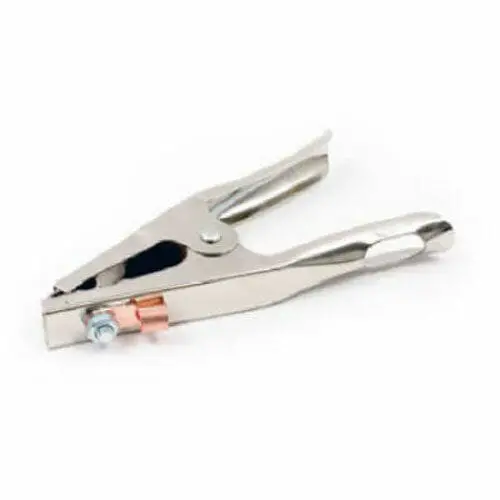 |
Our Top Pick
|
|
VIEW LATEST PRICE → |
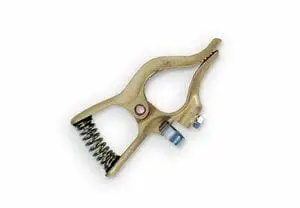 |
|
VIEW LATEST PRICE → | |
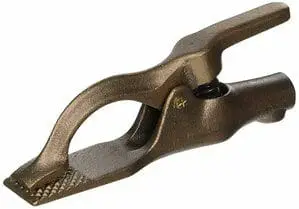 |
|
VIEW LATEST PRICE → | |
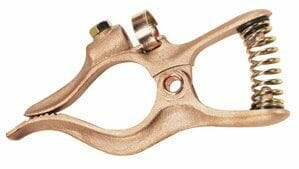 |
|
VIEW LATEST PRICE → | |
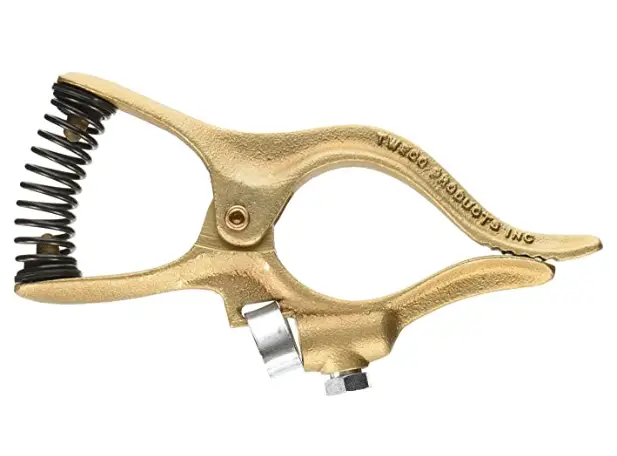 |
|
VIEW LATEST PRICE → |
By Gregory Sanders: This article has been updated to reflect the most accurate information regarding welding ground clamps available for those who are interested in welding security. The best 5 available have changed, and information has been added to assist individuals in finding the best welding ground clamps currently available on the market. The FAQ has also been updated.
Reviews Of Best Welding Ground Clamps
1. Forney 54410 Welding Ground Clamp
The Forney 54410 is easy to use. It has a 300 amp rating, ideal for light work.
It measures 8’ in length with a 1 ¾” wide jaw which makes it versatile for your projects’ metal dimensions.
Rugged and economical, the Forney 54410 ground clamp is great for shop maintenance and field work.
It provides a great ground for steel plates, angle irons, pipe work, etc.

2. Hobart 770031 400-Amp T-Style Ground Clamp – Brass
The Hobart 770031 is made of brass that ensures reliable current flow.
It is a T-Style ground clamp that 400 amp rating.
This opens to 3 inches and has a terminal hole of about a half-inch.
Unlike the stock clamp on some welders, this one contains no sheet metal.

3. US Forge Welding Heavy Duty Bronze Ground Clamp – 300 Amps
The US Forge Heavy Duty Bronze Ground clamp is designed with wide-grooved jaws for positive grounding.
This comes with a 300-amp rating and is ideal for heavy duty use.
Its oval-point screw cable connections make for easy installation.

4. Tweco 9205-1120 GC-200 Welding Ground Clamp
This clamp is available with either a 200-amp or 300-amp capacity.
The Tweco 9205-1120 GC-200 can be used in stick welding, submerged arc welding, gas metal arc welding, and gas tungsten arc welding. The Tweco 9205-1120 GC-200 is great for light and medium duty metal fabrication.
Other important features include a rugged and reliable copper cast design, ball-point screw to secure the welding cable to the ground clamp, and a heavy-duty insulated spring.

5. ESAB GC300 300A JR Ground Clamp Copper
ESAB GC300 is also available with either a 200-amp or 300-amp capacity.
This is a well built and heavy duty clamp with 300amp capacity. It's a great upgrade lower quality factory clamps which come with welding units. This clamp from ESAB is stout and requires some grip strength to open the clamp all the way.
The clamp is copper cast which has much greater conductivity than brass. It is a little pricey but certainly worth the performance increase as well as durability and sturdiness.
currently unavailable notable mention:
Lifbetter 300 Amp Heavy Duty Arc Welding Ground Clamp
The Lifbetter Heavy Duty Arc Welding Ground Clamp has a 300-amp rating, a copper-plated clamping surface and a strong spring.
It also comes with an extra copper strap on the sides that will give better contact.
Its rugged copper-plated jaws will securely clamp on to the work material and guarantees consistent conductivity. This Lifbetter clamp is a premium quality heavy-duty welder clamp.

Welding Ground Clamps - For Safety
In any welding project, whether you are a hobbyist, auto restorer, or a welder by profession, the success of the project relies not only on skill and equipment.
Safety is just as important, too.
Even with top-of-the-line welding equipment and high-grade welding knowledge and skill, you first need a healthy welder to utilize them.
Welding ground clamps (or “earth clamps”) help ensure proper voltage for optimum weld results using all types of rods.
Welding ground clamps establish a connection between the equipment enclosure and the ground, keeping the machine's metal enclosure and ground at the same potential. This is to avoid electrocution upon touching the two points.

Grounding the enclosure also limits the voltage on the enclosure. This serves as a precaution in case of an insulation failure in the equipment.
Using the right welding ground clamp not only ensures flawless projects, but more importantly protects against welding current restrictions, leakages, and poor welds.
There are different designs for particular jobs, including light duty, farm welder, field erection, or shop work.
Grounding Your Machine and Your Workpiece
A typical arc welding setup will be made up of several electrical circuits.
Applying and maintaining proper grounding methods within the welding workplace is essential to ensuring electrical safety.
Related processes such as plasma cutting are also helped by proper grounding.
Welding machines that are fitted with a flexible cord and plug array or those that are fixed into an electrical supply system contain a grounding conductor.
This grounding conductor connects the metal enclosure of the welding machine to the ground (or “earth”). If you trace the grounding wire back up the electrical power distribution system, you will find that it is typically through a metal rod driven into the earth.
The purpose of connecting the equipment enclosure to the ground is to ensure that the metal enclosure of the welding machine and of the ground is at the same potential.
This is so that the worker can avoid electrical shock when working, touching the two points. Grounding the enclosure likewise limits the voltage on the enclosure in case the insulation should fail throughout the equipment.
The welding circuit, of course, has to be made up of purely conductive material through which the welding current flows.
Electrical welding current travels through the welding machine through terminals, welding cables, workpiece connection, gun, torch, electrode holder and the workpiece itself.
The welding circuit is not connected to ground within the welding machine itself, but through an external piece driven to the ground. You must ensure that the workpiece or work table is connected to a suitable ground, such as a metal building frame. The ground connection should be independent or external from the actual welding circuit connection.
"Ground clamp" and "ground lead" are but some of the most common terms among weld workers. The workpiece is connected to a welding cable normally through a spring-loaded clamp or with a screw clamp.
Technically, a workpiece connection is often incorrectly referred to as a "ground clamp" by many.
The workpiece lead is misconstrued as a "ground lead."
It’s important to be aware that the welding cable does not provide a ground connection to the workpiece. The ground connection is independent from the workpiece connection.
Smaller welding machines usually will have a plug on the end of a power cord, and the grounding conductor connection is established when the welding machine is plugged into the receptacle.
Adapters that effectively “removes” the grounding pin connection at the plug is not recommended. Furthermore, cutting or removing the grounding pin from the plug should not be done for safety concerns.
So don’t use any of those 3-to-2 prong adapters, or non-grounded extension cords.
What To Look For In a Ground Clamp
Always remember: all electrical welding current flows through the ground clamp.
Without a suitable ground connection, the performance of the welder and the welding machine will be greatly compromised. This will leave you with inferior welds.
Ground clamps that work poorly can cause welding current limitations or even leakages. Simply put, poorly-working ground clamps will cause a decline in welding output voltage.
To avoid this, you need a welding ground clamp that has a reliable cable lug. The lug should fit the cable securely, keeping the lug bolt or terminal from coming loose. You want a clamp that comes with a firm cable connection that can withstand high cable strain.

You should also look for a welding ground clamp manufactured with sturdy material and with a good clamp design.
A solid brass cable terminal and jaws are most welders’ preference, because it provides a direct and reliable current flow. Finally, you want your clamp to be equipped with a solid clamp spring and clamp jaws that are not vulnerable to wear and corrosion.
A good lead work clamp is essential for proper and safe welding. Many weld workers prefer either a brass or bronze C-clamp style ground or a magnetic ground with a rotary connection.
This is because a high-quality spring clamp is less likely to cause disfiguring of the metal surface.
The copper strips that connect the cable to the clamp are often neglected, but this actually plays a role in reducing heat build-up on your work lead clamp.
Many weld workers also find line connectors with the “twist-and-lock” mechanism that connects cable to cable or cable to ground clamp. This also provides more secure connections, it can handle high electrical currents up to 150 amperes.
Another type of ground clamp ideal for high current welds is designed like a screw clamp and is made of bronze.
Don’t Be Part of the Ground
We have discussed at length the importance of welding ground clamps as a protection from electrocution and other implications of power surges in the process of welding.
What you should remember, though, is that it is likewise essential for welders to wear protective clothing to avoid any risks of burns.
Of all injuries to welders, burns are the most common due to the intense sparks flying out and landing on bare skin.
Even the eyes are prone to these risks with the exposure. The actual gear varies with each welding project but the rule of thumb is that protective clothing should allow for movement while providing maximum coverage against sparks, spatter, and radiation.
Precautionary measures must be taken to insulate yourself from the welding circuit by wearing dry insulating gloves and other insulating equipment. It’s also important to maintain insulation on your weld cables, electrode holders, guns, and torches.
Welding helmets, hand shields, and/or goggles are essential to avoid eye injuries that can be caused by the intense light and radiation that a welding arc can produce.

Eye injuries can also happen from hot slag and other metal debris that can fly off from the weld during cooling, chipping or grinding. It will also help to wear fire-resistant head coverings under the helmet, where appropriate.
Second, respirators will protect from fumes and oxides.
Third, flame-retardant clothing and aprons will protect from extreme heat, burns, and radiation.
Just remember that the pants should not have cuffs, shirts should have flaps over pockets or be taped or buttoned.
Fourth, ear muffs or ear plugs will shield the ears from irritations caused by loud noise.
Just make sure to use fire-resistant ear muffs.
Finally, make sure to use boots and gloves that will protect against electric shocks, heat, burns, and fire.
FAQs
What are welding clamps used for?
Welding clamps are used to hold down pieces of metal so that they are secure and safe to weld. They help create a stable welding environment so that the pieces you are working on don't shift around.
How many types of clamps are there?
There are 6 main types of clamps. They are:
- cable clamps
- locking clamps
- hose clamps
- hand clamps
- parallel clamps
- AC clamps
What does a welding ground clamp do?
Welding ground clamps connect the equipment enclosure to the ground, ensuring that the metal enclosure and the environment have the same potential. This is to avoid electrocution if the two points make contact. Grounding the section also serves as a voltage limiter.
Where does the ground clamp go when welding?
It is necessary to secure the ground clamp to the welding base material. Additionally, it should be within walking distance of the welding area. Indeed, you can clamp it directly to the plate that holds your workpiece; avoid securing it to anything leaning against a wall.
Can I weld on the ground?
The most common method of grounding a welding machine is to connect the ground wire to a metal rod in the ground. This is an excellent method for outdoor welding.
Conclusion
As we agreed from the beginning, safety should be a fixed consideration in any welding undertaking.
And welding ground clamps will accomplish more than just ensuring the welder’s safety – it plays a major role in maintaining consistent welding currents throughout the work.
Before embarking on any welding project, any experienced welder would know which the suitable welding ground clamps are that’s best for any particular project.
It pays to remember: “you’ll never get a good weld with a bad clamp.”


